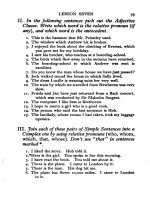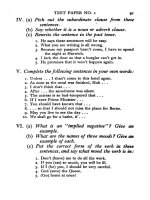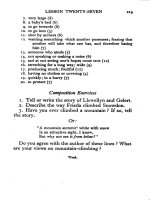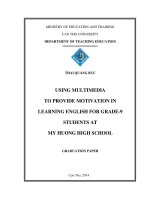Essential english for foreign students book 1
Bạn đang xem bản rút gọn của tài liệu. Xem và tải ngay bản đầy đủ của tài liệu tại đây (9.73 MB, 256 trang )
FOR FOREIGN STUDENTS
Book l
BY C. E. ECKERSLEY
ESSENTIAL
“ENGLISH _
Or |
Foreign Students
_ BOOK ONE
revised edition
by
C.E. ECKERSLEY
Illustrations by _
CHARLES SALISBURY,
BURGESS SHARROCKS
and from‘ Punch’ and‘ The Humorist’ _
FOREIGN LANGUAGES PRESS ' _
Sofia. 1967
PREFACE
ESsENTIAL ENGLISH is a course in four books, of which this
is the. first, for the teaching of English to adult foreign
students. It aims at giving the student a sound knowledge
of the essentials of both spoken and written English and
taking him well on the way to a mastery of idiomatic
conversational and literary English.
. The normal constructior ns and sentence patterns of English
are introduced gradually and systematically, and are well .
drilled at every stage. The learner is guided through
“essential” grammar in the simplest possible manner, and
every new construction is explained and illustrated as soon
as it is used.
The restricted vocabulary within which the four books are
written has been based on A General Service List of English
Words* But neither this list, nor any other list, has been
followed slavishly and blindly; the vocabulary and the
grammar and the structures taught have been tested constantly
by the experience gained during some thirty years of teaching
English to foreign students or writing text-~books for them.
“Because I believe that 2 knowledge of the spoken tongue
is the true basis of language learning, much of this book is in
**conversational”’ form; and my constant endeavour has been
to ensure that, despite the restrictions that a limited vocabu-
lary naturally imposes, every sentence in these conversations
is expressed in the living, colloquial idiom that an educated
Englishman would use.
And, since the most effective spur to learning a language
(or anything else) is interest, every effort has been made to
cover the linguistic pill with the jam of gaiety. So, as soon as
1 A new edition of the Interim Report on Vocabulary Selection
(Longmans).
iii
"iv PREFACE
- the preliminaries are mastered, the reader is introduced to
Mr. Priestley, his household and his group of students. We
see them here and in subsequent books chatting together,
telling jokes, reading stories that they have written, singing
songs or acting short plays. It is on these conversations and
stories and the “‘talks by Mr. Priestley’’ that the language
teaching is based, and from them that the copious exercises
by which the teacher is enabled to test how far the work has
been understood, are drawn. .
Fundamentally, this new edition of EssENTIAL ENGLISH is
the same as the old one, but there are one or two changes.
Some extra material has been added; the Future Tense has
been treated rather more fully; comparison of adjectives,
which originally was delayed until Book IT, is now treated
here in Lessons 20-22; Lesson 11 has been expanded; there
are two new “‘Stories without words”’ (page 155 and 166);
the sections on sentence construction have been deferred to
a later book and an index has been added.
In the Teacher’s handbook? that has been prepared to
accompany this volume the general principles and the main
techniques of language teaching are discussed, detailed
suggestions and practical hints are given on the teaching of
each lesson, and a complete Key to the Exercises is provided.
Though a text-book that is the ideal one to every teacher
and student is, perhaps, an impossibility, it is hoped that
most students and teachers will feel that this new edition is
an improvement on the old one, but the author will be most
grateful at any time for further criticisms and suggestions
that wiil help to make EsseNTIAL ENGLISH more useful to
those who study it or teach from it.
C. E. E.
August 1955.
` 1 Essential English, Book I, Teacher's Bock.
CONTENTS
*+ PAGE
THE SOUNDS IN ENGLISH ° . ` . ` Vii
LESSON "
1 THe First ESSENTIAL STRUCTURES ` ` .
2 “THE FIRST ESSENTIAL ŠTRUCTURES (2) .. . .
3 Prurats. ‘THERE Is ... THERE ARE...” . . 18
4 QueEsTIOoN Worps. GENDER . . : . . 30
s Tue Vers “To Be” ` ee . . 37
6 Reavinc Lesson. ‘‘THE Farm” . . . . 42
7 PossessivE ADJECTIVES. PERSON. THE SIMPLE
Present TENSE . . ` . .
8 Tue Present ConTINUOUS TENSE . - 2
g ‘Tre Verss “Have” AND “CAN”, .. .
10 READING Lesson. “‘ THE SEASIDE”’ ` . `
t1 "THME. DAYS, MONTHS, SEASONS. POSSESSIVE CASE .
x2 Tue Past Tensz,:“ To Be,” “To Have,” “Can” .
13. THe CHARACTERS IN THE Essential English Booxs
(1) Mr. Priestley . . . . . . 93
14 THe SrmpLe PRESENT TENSE . . . 99
15 Discussion or Lesson 13. SiMPLE PRESENT "Tense
NEGATIVE . . . 2 . . 105
16 SUBJECTS AND BJECTS . 117
17 ‘THE CHARACTERS IN THE Essential English Booxs
(2) Mrs. PRIESTLEY AND SOME OTHERS. . 124
x8 THE Future TENSE . . 130
1g THE CHARACTERS IN THE Essential English Boos
(3) THe Stupents . . . . . . 138
20 COMPARISON OF ADJECTIVES (1): . . ‹ ° 147
21 THe STUDENTS TALK TOGETHER. ON “LIKES AND
DisLiKES `” . . . . : 157
22 COMPARISON OF ADJECTIVES (2) . . . 168
23 ““THe Car THAT CAUSED A WEDDING.’ ” REGULAR
AND IRREGULAR VERBS . . 2 sa . 177
CONTENTS
.ESSON PAGE
24 Tue Srmp_e Past TENSE 179
25 IRREGULAR VERBS. PAST TENSE NEGATIVE AND
INTERROGATIVE 186
26 COMMENTS ON LESSON 25 . . 102
27 'THE STUDENTS TALK TOGETHER ON “Ý FoooD”’ .. 190
28 IRREGULAR VERBS . 208
29 THE PRESENT PERFECT "TENSE (1) 214
30 THE PRESENT PERFECT TENSE (2) . 220
31 Tue Present Perrect TENSE (3). More DirFicutt
EXAMPLES . . . 226
32 THE PRESENT PERFECT TENSE (4) 231
APPENDIX:
PRINCIPAL PARTS OF THE TRREGULAR VERBS IN.
Essential English Book I . 236
Grammatical Terms IN Essential English .
Boox I . 238
PRONOUNCING VOCABULARY OF _ Essential English
Boox I 239
INDEX . . 247
1
Phonetic THE SOUNDS IN ENGLISH
Symbol
VOWELS |4
Examples
v8 9 M mm me, tree, three, he, people, the!
ship, it, ticket, this, king, shilling
bed, pen, egg, yes, men, well “|
man, that, am, and, Paris, can, Spanish
past, dark, arm, are, car, hard
not, lot, wash, song, from, rock, coffee
all, small, ball, or, forty, morning
put, full, look, good, foot, book
who, move, noon, blue, do, too
up, cup, much, sun, some, but
her, Thursday, burn, third, thirteen, worth,
. work
a, the’, under, father, address, servant, Saturday
|1| DIPHTHONGS
ei say, baby, train, plate, table, waiter, Spain
ou no, smoke, those, motor, only, Poland, hotel
al five, nine, ice, eye, my, side
au how, count, flower, clouu, hour, now
boy, noise, boil, voice
21
12 dear, clear, beer, really, ear
ca where, there, their, chair, hair, care
933. / four, door, your, more, floor
|
us / “sure, poor ‘ |
1 aA form.
3 form.
3 N y speakers of Standard English do not use this sound. They
use, instead, [9:].
vil
Phonetic COMSONANTS
Symbol
Examples
“2g "4 By an aN Owe Pe OO wat ors pen, pay, people, pull, open, inkpot, help
be, bath, boy, bad, husband, bed, beef
train, tree, sit, tea, inkpot, table, hotel, stop
_ door, day, sad, kind, desk, Friday, word ©
cold, back, clock, car, class, king
gold, bag, girl, dog, good, go, egg-cup
fine, far, safe, flower, fifteen, after
very, save, vegetable, seven, never
thank, thick, thin, nothing, think, twentieth
_ then, that, there, weather, with, together
so, sit, sleep, thinks, place, cigarette
zero, has, knives, comes, plays, noise
ship, sharp, fish, English, shilling, short
pleasure, measure
Charles, each, Richard, much
John, judge, age, Japan, language
his, happy, here, help, unhappy
man, make, many, my, swim
name, near, then, finish
sing, thing, working, English, king
red, around, very, rich, every, room
leave, long, full, pull, greatly, last
will, work, away, when, window, wash
yellow, year, you, young, yes, piano
52 o> THE ENGLISH ALPHABET
C D E F. G H IT J K L
oOo
ec doe f g h ij * 1
P Q@ RS T-U VW X Y
P q*srs t uvw x y
LESSON 1 (First Lesson) ©
Number 1 (one):
^WWΠNumber 1 is a man.
This is a man, +
Number 2 (two)
“Gee Number 2 is a woman.
This is a woman.
Number 3 (three)
“Q@RE This is a boy.
Question: What is this? |
Answer: This is a boy. |
“WE This is a girl.
Question: What is this?
. WHAT'S _ Answer: This is a girl.
THIS ?
* 1*
2 ' ESSENTIAL ENGLISH
‘Number 5 (five)
THIS ISA `
. 0 4 `
ta *%
`
_. Number 6 (six)
irs by“pyLF » Question: What is this?
|
: ®
Answer: It is a train.
Number 7 (seven)
Question: What is number 7?
Answer: Number 7 is amountain.
Number 8 (eight) - `
{ Question: What is number 8?
Answer: Number 8 is a clock.
i
Number 9 (nine) LESSON ONE 3
Question: Is this a tree?
QUESTION ANSWER
- Question: Is this a ship?
= Answer: Yes, it is.
Number | rr (eleven) Question: Is this a ship?
ances
Answer: No, it is not a ship;
fir falls 1
A / Si
it is a cigarette.
Number 12 (twelve)
Question: Is this a cigarette?
Answer: No, it is not a cigarette;
itisa horse, -
4 ESSENTIAL ENGLISH
Number 13 (thirteen)
“@BE This is a man and a boy.
AND
Question: What is this?
Answer: It is a woman and a
baby.
_ Question:
Is this a woman and a
baby?
Answer:
No, it is not; it is a cat
and a dog.
Number 16 (sixteen)
Question: Is this a cat and a dog?
Answer; No, it is not; it is a_
hammer and a nail.
LESSON ONE
PRONUNCIATION DRILL
[i] VOWELS AND DIPHTHONGS
tf «ff fa
three 1 yés man
fourteen ten cat car
tree this eleven | hammer answer
fifteen _— six
thirteen seven
sixteen ship question
is twelve
baby - cigarette
mountain lesson
eleven
fifteen “
in
sixteen
cigarette
not bị b9] tuị [uz] [4]
_ four woman two
what horse put number ˆ
dog _ fourteen - one [wan]
clock
girl[2] a [>] fe} Pow fai]
train no. five
word woman baby - mOtOF nine
thirteen hammer __ nail write
first motor eight
answer -
and
[au] [oi]
mountain boy
toys
CONSONANTS
[3] (voiced) this ' [t] ten, tree, train, thirteen
[0] (unvoiced) three, thirteen’ [h] horse, hammer
6 sóc ESSENTIAL. ENGLISH
EXERCI SES
I. Put in the missing words:
Number 8 —- —- —
» LESSON ONE
What is Is this a
man and
this? a boy?
It is — —
What is this? . What is this?
———_—— _—_ ~— =—— —— ——
Is this a cigarette? Is this a cat and a dog?
~_— — —— —_———_— ——
Is this a cigarette? | BUNS
No, —— — Ts this a cat and a dog?
————
*
„18 ESSENTIAL ENGLISH
II. Write in words the numbers 1 to 16, e.g.:
I 2 eee
one. two oot
III, Answer the questions:901 AN YPPym
What is number 1?pwW DN oe oOrat
What is number 2, etc.? (to number 16)
Is number 1 a man?t t
Is number 2 a woman?
Is number 3 a boy?M tt
Is number 4 a train?90 ON A
Is number 5 a mountain?
Is number 6 a woman?
. Is number 7 a girl?
Is number 8 a clock?
. Is number 9ga tree?
Is number Io a cigarette?
. Is number 14 a woman and a baby?
. Is number 15 a. hammer and a nail?
. What number is a man? (Answer: Number one is a man.)
. What number isa ship? ,
. What number is a horse?
. What number is a hammer and a nail? -
. Is number 12 a horse? »
. Is number 16 a cat and a dog?
Dictation
Man, woman, boy, girl, motor-car, train, mountain, clock,
hammer, nail, first.
This is a cigarette. This is a cat and a dog.
Number LESSON ¿ (Second Lesson)
17 (seventeen)
Number seventeen is an inkpot.
What is number eighteen?
It is? an ice-cream (or an ice),
Is number nineteen an apple?
Yes, it is.
Mee
typ
‘ft
Number 20 (twenty)
| Is this an apple?
Cà | Is it an ice? |
What is it? ‹
Se" It is (it’s) an eye.
iN :
1 97, in the short form generaily used in conversation, “It’s an ice.”
a
z
2—I
1e ESSENTIAL ENGLISH
Number 21 (cwenty-one).
Is this aship?
Is it a clock?
What is it?
It is (it’s) a cat and an umbrella.
Is this an umbrella or an
aeroplane? |
It is (it’s) an aeroplane,
Number 23 (twenty-three) _
Is this an egg or anapple?
It is (it’s) an egg.
Number 24 ('cwenty-four)
This is a bad egg. This egg is bad.
Is this a good ces Is this egg
good?
i No, itisnot.
I It is (it’s) a bad egg. Itiis bad.
It is (it’s) a ‘bad one. It is not (it isn’t) a. good one.
i This short form is generally used in conversation.
LESSON TWG _ "I
SAS "nnmm
VOWELS @
— —— : TA
BỊC|D|IFIGIH NmmÌ|©.
K;LIMIN| P/Q
4 Is iriv iw xl
CONSONANTS
— — 3
a before (in front of) a consonant sound.
an before (in front of) a vowel sound.
in
The egg is in the egg-cup.
_ The boy is in the bed.
The girl is in the classroom.
The train is in the station.
The aeroplane is in the sky.
| Question me.
Where is'the egg? The egg is in the egg-cup.
Where is the boy? The boy is in the bed.
Where is the girl? _ (Put ién the answers.\
Where is the train? |
Where is the aeroplane?
4Short torm Where’s
12: ESSENTLAL ENGLISH
on .
The cigarette is on the table.
-_ The ship is on the sea.
The clock is on the wall.
The apple is on the plate.
under
The cat is under the umbrella.
The mouse is under the table.
What is under the um-
=8 brella?
os” The cat is.
What is under the table? is” “nottrút
The mouse is.
Is the egg in the egg-cup? Yes, it is.
Is the cat under the umbrella? Yes, it is.
Is the train in the sky? No, it isn’t.
Is the dog under the umbrella? No, it
isn ‘the
PRONUNCIATION DRILL
ff] . fy fe] sf] [a]
sea —. Ít egg — bad class
seventeen twenty seventeen apple :
eighteen give - bed ~~. grammar
nineteen = ink umbrella
cream before — twenty
~ the1 second ©
1 Before a vowel sound,









